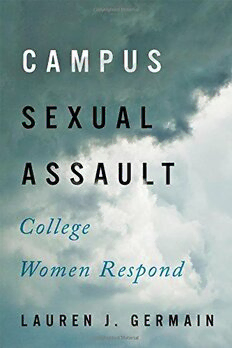
Campus Sexual Assault: College Women Respond PDF
Preview Campus Sexual Assault: College Women Respond
Campus Sexual Assault This page intentionally left blank Campus Sexual Assault College Women Respond Lauren J. Germain JOHNS HOPKINS UNIVERSITY PRESS BALTIMORE © 2016 Johns Hopkins University Press All rights reserved. Published 2016 Printed in the United States of America on acid- free paper 9 8 7 6 5 4 3 2 1 Johns Hopkins University Press 2715 North Charles Street Baltimore, Maryland 21218-4363 www . press . jhu . edu Library of Congress Cataloging- in-P ublication Data Germain, Lauren J., 1983– Campus sexual assault: College women respond / Lauren J. Germain. pages cm Includes bibliographical references and index. ISBN 978-1-4214-1905-3 (hardcover : alk. paper) — ISBN 978-1-4214-1906-0 (electronic) — ISBN 1-4214-1905- X (hardcover : alk. paper) — ISBN 1-4214-1906-8 (electronic) 1. Rape in universities and colleges— United States. 2. Women college students— Crimes against— United States. 3. Rape victims— Rehabilitation— United States 4. Rape victims— United States— Psy chol ogy. I. Title. LB2345.3.R37G47 2016 364.15'320973— dc23 2015022720 A cata log record for this book is available from the British Library. Special discounts are available for bulk purchases of this book. For more information, please contact Special Sales at 410-5 16-6 936 or specialsales@press . jhu . edu . Johns Hopkins University Press uses environmentally friendly book materials, including recycled text paper that is composed of at least 30 percent post- consumer waste, whenever possible. To the brave individuals who told their stories and to those who bear witness and are moved This page intentionally left blank Contents Preface ix Ac know ledg ments xiii 1 What We Don’t Know about Campus Sexual Assault 1 2 The Paradox of Embodied Agency 23 3 Managing Identity 39 4 Telling Friends and Family 54 5 Seeking Justice 71 6 The Beautiful Pro cess of Empowerment 89 7 Agency and Campus Sexual Assault: The Way Forward 96 Appendixes A Participant Demographics and Case Details 109 B Methodological Notes 110 C Supplementary Ideas 111 Notes 113 Bibliography 117 Index 123 This page intentionally left blank Preface One eve ning, many years ago, a courageous young woman shared her story with me. At the time, her narrative was in fragments, pieces of sentences punctuated by long pauses where she searched for the next word. She had been raped at college, although she didn’t use those words to describe the experience at the time. My response was likewise splintered because I w asn’t sure what to say or do, but I listened and promised to “be there.” Being there has meant bearing witness and working to more deeply un- derstand the issue and impact of campus sexual violence. There is research on the prevalence of such violence and some studies on college women’s responses to attacks that focus attention on how rarely cases are brought to hearings and trials. Yet when I spoke to women who attended college, I realized that something major was missing from the academic literature on campus sexual violence: real stories, complete in their fragmentation, that include women’s responses to these violations and the motivation behind their actions. In listening to their stories, I came to understand campus sexual violence differently and more fully. As previous research has noted, these are stories about adversity, but they are also about the women’s own power and agency. By agency, I mean an extension of Laura Ahearn’s definition from one’s “socio- culturally mediated capacity to act,” to include motivation and action.1 This book is founded on shared stories and shifts the focus from adversity alone to “agency in adversity.” Campus Sexual Assault is about what women did in the aftermath of campus sexual violence. The pro cess of collecting stories and sharing them was one of collective or shared agency. In simply asking “what did you do?” I learned about both diversity and commonality. Most importantly, all of the women who told their stories did so with a goal of increasing aware- ness and helping others. In reading this book and reflecting on what they say, you too contribute to the accomplishment of this aim. Deciding how to compile these stories was an exercise of my own agency, and I want to be clear about some of the choices I made. I focused
